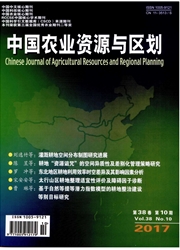

 中文摘要:
中文摘要:
[目的]内蒙古自治区是我国土地整治的重点区域,但各地级市差异明显,各类整治工程效益迥异。根据不同盟市发展与地区定位,从自治区层面综合分析不同类型土地整治综合效益,确定地区土地整治目标和重点,对部署土地整治战略具有重要意义。[方法]文章使用灰色关联模型,选取经济、社会和生态3方面共10个评价指标,应用层次分析法,对内蒙古自治区“十二五”期间12个盟市的土地整理、复垦和开发工程的综合效益进行评价。[结果]内蒙古整理工程综合效益最显著的地区位于东部的赤峰市、通辽市、兴安盟和呼伦贝尔市4盟市,复垦工程综合效益最显著的地区位于通辽市、兴安盟和西部的巴彦淖尔市和鄂尔多斯市等传统煤矿产区,开发工程以鄂尔多斯市、巴彦淖尔市和通辽市综合效益最为显著。依照不同类型土地整治工程综合效益位序排列,内蒙古12个盟市可划分为4类,其中第I类为均衡发展重点整治区域,第Ⅱ类为土地整理工程效益优先区域,第Ⅲ类为土地复垦工程效益优先区域,第Ⅳ类为复合类型整治区域。与第I类区域相比,后3类区域各类工程综合效益略低,但具有明显的优势类型。[结论]作为我国土地整治的重点区域,内蒙古土地整治工作应考虑不同区域发展条件的差异和经济发展水平的地域差异,因地制宜,适度整治。
 英文摘要:
英文摘要:
Inner Mongolia Autonomous Region is located in northern of China, where showed obvious spatial heter- ogeneity among different levels of cities, and hence the benefits of land consolidation projects were also various. This study determined the objectives and priorities of land remediation and the deployment of land remediation strat- egy, so as to provide a reference for the layout of the 13th Five - Year Plan of the autonomous region. The grey cor- relation model with 10 indicators in terms of economic, social and ecology was used to evaluate the comprehensive benefits of land consolidation, reclamation and development projects. The results showed that the gray relational model was accurate and easy to operate. The autonomous region had achieved remarkable results in 12th Five - Year. The land consolidation projects distributed widely, which concentrated in the traditional coal mining area. The development projects focused on the areas where natural conditions were suitable for cultivated land. The most significant area of the comprehensive benefits of the project was located in Chifeng, Tongliao, Hinggan League and Hulun Buir City. Tongliao City, Hinggan League and the western Bayan Nur City and Ordos City. The most com- prehensive benefits of reclamation project were in the traditional coal mining areas, while the most comprehensive benefits of the development projects were in Ordos City, Bayan Nur and Tongliao City.. According to the compre- hensive benefit, the 12 cities in Inner Mongolia can be divided into 4 categories. Class I was in the balanced -de- velopment area, including Tongliao, Hinggan, Chifeng and Bayan Nur 4 cities. Class II was in the priority areas, including Hulun Buir and Ulanqab. Class III was in the areas of land reclamation, including Alax League and Wu- hai City, Xilin Gol League. Class IV was in a composite type remediation area, including Baotou, Hohhot and Or- dos. Compared with the Class I, the comprehensive benefits of latter three classes were slightly lower, but had ob- vious adv
 同期刊论文项目
同期刊论文项目
 同项目期刊论文
同项目期刊论文
 期刊信息
期刊信息
